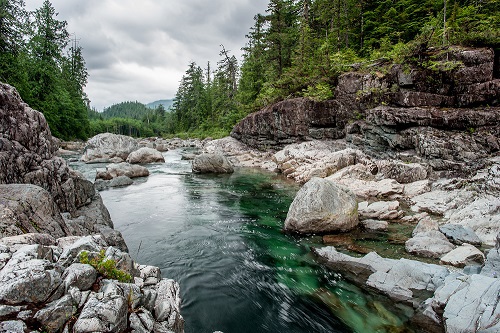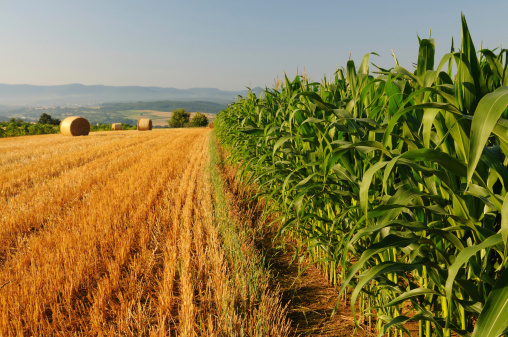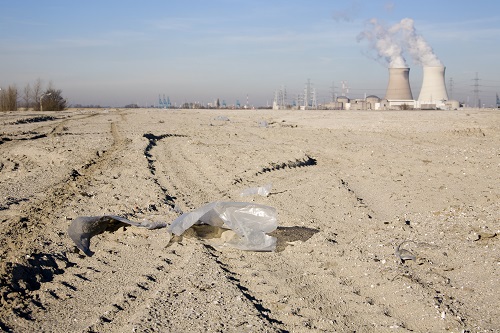How secure is Canada's water?

If you’ve taken an economics course, you’ll have read about the Diamond Water Paradox, or the Paradox of Value. In a nutshell – despite water being crucial for one’s survival, its value is insignificant in relativity to diamonds, which are not crucial to one’s survival.
The economist Adam Smith is largely credited with this discussion which outlines the concept of Marginal Utility. The concept of Marginal Utility holds that as the quantity increases, each additional unit of a given product or item will provide a decreasing amount of utility or use to an individual (and hence a lower value). Given the (almost) unlimited supply of water in the world versus the limited supply of diamonds, the value of each unit provided of each item differs greatly.

California Drought
While access to fresh water affects millions of people worldwide, until recently it hasn’t been as significant an issue in North America. A combination of both supply and demand factors have led to one of the worst droughts on record in California, leading to the declaration of a ‘drought state of emergency’ in that State. Although both mainstream and social media can’t stop talking about it, this drought has been a long time coming, and hasn’t just happened overnight. In fact, it’s an issue facing many regions of the United States. Why is there such a major focus on this one state? California produces about 50% of ALL the fruit, vegetables, and nuts consumed by the entire United States.
What’s on your plate? Water or Vegetables?
In 2013 Canada imported $21.3 billion worth of agricultural products from the United States, $3.6 billion of which was for fresh fruit and vegetables. Interestingly enough, the US imported $21.8 billion worth of agricultural products from Canada in the same year. While it’s hard to summarize statistics, it appears that we import more fresh fruits and vegetables, and export more meat, vegetable oils, animals, and processed fruits and vegetables. Not surprising, given our seasonal climate.
As mentioned in our post, Food and Shelter, over the past few years grocery prices have been on the rise. While fuel prices were implicated as part of this rise, water supply issues are a key component. How much of California’s water supply does the agricultural sector use? Most of it – farms using an estimated 80% of the water taken out of the environment, or “developed water”. This is an easy ratio to comprehend, but a more interesting way of looking at it is the amount of water each specific crop uses.
Lettuce and broccoli, two fairly common vegetables on a Canadian plate, are two of the biggest consumers of California water. One broccoli crown uses almost 20 litres of water, while one head of lettuce uses over 12 litres.
If one were to measure water consumption for crops on a pound by pound basis, the much vilified Almond would likely be sitting at the top of the guilty pile. One single Almond uses about 4 litres of water. As the supplier for 80% of the world’s almonds, this crop accounts for almost 10% of the annual agricultural water use in the State of California. Taking into account that agriculture only contributes 1.5% of California’s GDP, water consumption between agricultural and non-agricultural users has become a hot button.
The price of BC’s Water
Head north now, up to beautiful British Columbia. While we have not had any real pressing water shortages yet, we have had our own fiery social and political debates on the price of this resource. In particular for one industry user, water bottling plants.
One such water bottling plant is owned by Nestle. Situated in Hope, BC, this plant had been operating fairly quietly since they acquired it from the previous operator, Aberfoyle. That changed in 2013 when the provincial government announced the establishment of the Water Sustainability Act. This Act was brought in to manage our extensive water resources more comprehensively. From what we can tell, Nestle’s operation was used in the press as an example of what the cost of extracting water would be for this type of user. When the general public discovered what Nestle was paying for water, there was a significant amount of outrage expressed.
Under the new legislation, Nestle pays about $2.25 per 1,000 cubic metres, or 1,000,000 litres – this value is up slightly from before. Essentially, Nestle pays the same for 1,000,000 litres as you do for a single bottle at the corner store. Of course Nestle has developed the infrastructure to extract the resource- they provide jobs, and need to market and ship the product. The fact is though, $2.25 is neither an amount that will break Nestle financially, nor does it appear to be representative of how much water should be worth. Much like the poor Almond, Nestle has now been attacked on social media and in the press for being an evil corporation that is profiting from our highly valuable resources. By the way, Nestle is not the only water bottling plant in the Province, far from it.
What about other users of this prime resource? Under the new legislation, agricultural operators pay about one third of what Nestle does, about $0.85 per 1,000,000 litres. Most other water users will fall in between these two rates.
We’re not here to defend Nestle, nor argue whether or not its rates are reflective of the price of water, but to outline water use in a greater context. With the exception of a few areas in the interior, British Columbia is not at risk of running out of water yet. Relative to California our principal watersheds are in fairly good shape. Compare the Fraser River with the Colorado River, the principle river for the Southwestern US and Northwest Mexico. The Fraser River reaches the Pacific Ocean with a volume of some 208 million litres per minute, while the Colorado River no longer reaches the Pacific Ocean. In fact, it ends about 100 kilometres from its previous terminus in the Sea of Cortez leaving ahead of it a long stretch of dry sand.

Canada – More Fresh Water than we need?
Canada has about 20% of the world’s total fresh water supply. Less than half of this amount though, estimated at 7% of the world’s total, is considered to be renewable (part of the annual hydrologic cycle). Consider now that most of this water flows towards the Arctic Ocean and Hudson’s Bay, well away from most of Canada’s population, and we begin to see that perhaps our great water resources might not be that great.
Oil Pipelines vs. Water Pipelines
Canada’s Ambassador to the United States, Gary Albert Doer, was quoted as saying “I think five years from now we will be spending diplomatically a lot of our time and a lot of our work dealing with water,” he said. “There will be pressure on water quality and water quantity.” He also stated that the recent debate between Canada and the US with respect to the Keystone XL pipeline will ‘look silly’ by comparison.
Luckily for Canada we have yet to export water on a bulk basis. Although we do export a lot of bottled water, estimated at between 100 and 500 million litres annually, the majority of the water bottled in Canada is reportedly consumed in Canada. Whether water exports change in the future is largely based on the interpretation of what constitutes a commodity under the North American Free Trade Agreement. At present, water is not defined as a commodity. Considering the pressure on water resources, we expect this will eventually be challenged.
Using this information, does the current pricing of water adequately reflect the value of water? Based on the concept of Marginal Utility on a Global Scale, our water supply is not very well priced. In fact, from an economic perspective we should be piping our water directly to California. After all, without California (and many other areas) we would have a much more limited variety of fresh fruit and vegetables. Can you imagine how many greenhouses we would need to supply BC’s population with fresh vegetables every day in the winter? Ok, so maybe piping our water is not a great idea, but pricing water based on local use might not make sense any more. Considering how many of our imports require fresh water as a production input might make us think a little differently when we use our resources locally.
Sources:
Researched and authored by: Alan L. Johnson of Colliers Unique Properties (604) 661.0842
http://can-am.gc.ca/washington/offices-bureaux/hom_message_cdm.aspx?lang=eng
